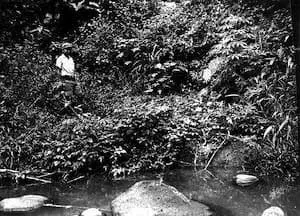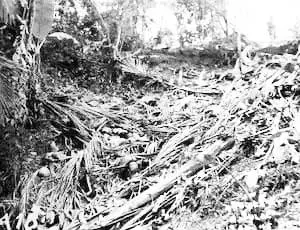WWII Japanese Atrocities Committed in the Barrios of Lipa
In a previous article, I had written that the Japanese, particularly towards the end of their occupation in the Philippines, had massacred an estimated 25,000 Batangueños. The most number of deaths was in the then town of Lipa.
These massacres and other atrocities are further documented in barrio histories required of all Department of Education districts by then-President Elpidio Quirino in 1951. These documents are publicly available at the National Library of the Philippines Digital Collections.
Because these local histories were written six or seven years after the end of the war, memories of these atrocities were still fresh. In this article, we take a look at excerpts, all cited verbatim from the documents, to show younger readers in particular the horrors of war, in the hope that darkness that enveloped the entire world in those days may never revisit us again.
Adya
“The latter part of the Japanese occupation was the period of greatest miseries and hardships. People had to leave their homes, sleep in secluded places for fear of being caught by the Japanese raiders. Several persons of the barrio were killed and nearly all the houses in the northern part of the barrio were burned in one of the raids undertaken by the Japanese. One of the most atrocious acts done by the Japs in the place was the burning of a blind man and his old mother by tying them to the house while it was set on fire1.”
Anilao
“But the most unforgettable event was the massacre of all the male inhabitants numbering four hundred and fifty-one (451), and the burning of houses totaling one hundred and twenty-two (122), by Japanese soldiers during the Japanese occupation. This event took place on February 27, 1945. It was followed by the killing of a parish priest and two boys of the locality on February 28 of the same year. The massacre was so insidiously planned that barely seven men escaped its savagery. The male inhabitants were enticed under a pretext of protection and immunity from arrest that they voluntarily assembled at a certain place. They were tied up and bayoneted2.”
Antipolo
“In this barrio alone, there were two check points with (Japanese) garrison troopers. Everybody must bow properly when passing the sentry. Anybody refusing to bow was punished: slapped, kicked or butted with a rifle… Every night then, the Japanese patrolled place for nocturnal visitors. Anybody seen at night was shot… (This next sentence refers to the same massacre mentioned in the Anilao document) Since then, those who went to town were never heard of except for one who luckily escaped death, despite his 17 bayonet wounds in all parts of his body3.”
 |
| Unidentified man stands at a river site of a mass killing by the Japanese during World War II, in Batangas Province, Luzon, Philippines. Image credit: United States National Archives. |
Bulacnin
“Sometime in 1945 – just a few months before liberation – the Japanese soldiers, desperate as they were, started burning houses, killing men, women and even innocent children. The height of the Japanese atrocities orphaned many children, widowed many mothers and left many families homeless. Included among those who joined the “innumerable caravan” (presumably the ‘insidious massacre’ mentioned in the Anilao and Antipolo documents) were the mother and wife of Mayor Jose M. Kalaw, the Salas Brothers and the Latorre sisters4.”
Cumba
“During these months (September 1944-March 1945), the Japanese were the height of doing their atrocious acts in the form of rape, arson and massacres… During the night of December 31, 1944, twenty persons including boys were caught in a surprise raid. They were taken to the Japanese Army camps. Only a few managed to escape. The rest were killed… The mass raid in Sampalucan, a sitio of the barrio, occurred in the early morning of February 19, 1945. About sixty innocent persons, mostly old and weak, were killed in this raid. They were tied and stabbed with bayonets5.”
Labak
“During the Japanese occupation, day after day some Japanese soldiers were making friends with the barrio residents. Unaware of what will happen, the people did not leave their homes. Until on February 27, 1944 (this was probably 1945), the same Japs assembled in three big houses of the village where every individual they saw was killed as they went from house to house. Babies were thrown upward and the bayonets caught them as they fell. Then, at noontime, three houses were burned simultaneously6.”
Malagonlong
“The barrio was raided twice by the Japanese. The first was in September 1944. Five men were killed in this raid. One of them was Mr. Faustino Estolano, the barrio lieutenant at the time. The second raid was in February 1945. In this raid, forty persons were killed. The barrio suffered the greatest loss during this raid. All the properties of the people were confiscated and after his, all the houses except three were burned… According to reliable information, not less than sixty persons were killed in this barrio during the Japanese occupation7.”
 |
| Dead bodies in Sulac, Lipa City covered with coconut fronds and other leaves. Image credit: United States National Archives. |
Malalim na Lodlod
“During World War II, the people of Lodlod suffered incredible hardships under the Japs. All kinds of food became scarce and the people were all panic-stricken. Between 1941 and 1945, the barrio people witnessed and underwent the most horrible destruction of human lives and properties. Hundreds of human lives were mercilessly massacred. Their houses and other belongings were burned. Those belongings that were spared by the fires were stolen8.”
Munting Pulo
“When the Japs learned of the arrival of the Americans, they became desperate. They killed people and burned houses. The farmers abandoned their farms and began to prepare for mass evacuation. They brought with them their families, animals and household belongings. They moved forward not knowing where they would go. The people decided to go to Maugat, a barrio of Rosario. There, they built huts and stayed for several weeks. Later, they were ordered by the guerrillas to go to Ibaan9.”
Pangao
“Early in the morning of Sunday, February 8, 1945, a company of Japanese soldiers, numbering about 80, armed to the teeth, arrived in Pangao. Arriving in the place, still dark, they entered houses and ordered all males to go down. Then, they tied the hands of their would-be victims. Those who refused to be tied were at once bayoneted or shot to death. Then, they tied their captives in chains, sometimes five or more to a chain. Some captives were made to line at the backyard and were fired at by Japanese soldiers. A great number of them were assembled near the well. They were forced to jump into the well. Those who would not jump were shot right away, then thrown into the well… Not satisfied with this and to complete their monstrosity, the Japanese soldiers gathered heavy objects such as stones, pestles and mortars, benches and even frying pans and dropped these into the well… As a finishing touch, they rained many hand grenades down into the well10.”
Pinagtongolan
“This time, the Japanese were so ferocious and bent on killing all Filipinos they could see. They ransacked the barrio for food and clothing. Except for a few courageous ones, all seemed afraid at the sight of Japanese soldiers… The Japanese even went to the extent of wanting to massacre all the people. They issued a warning to all that ‘Golden is the Filipino who will be able to see an American.’ Not contented with this, they burned some houses near the school building11.”
San Jose Patay
“It is a lamentable fact to know that during the enemy occupation, some inhabitants of this barrio were killed by the Japanese soldiers. About forty persons were massacred in Tipakan, a barrio adjacent to this place. These people were evacuating hurriedly in fear of the Japs when, unfortunately, they met a group of godless Japanese soldiers12.”
 |
| Ruins of a primary school in Batangas Province, Philipines where Japanese assembled hostages before executing them. Image credit: United States National Archives. |
Sapac
“The whole population of the barrio suffered much during World War II. The brutal and heartless Japanese soldiers seized the foodstuffs of the people such as rice, corn, chickens, hogs and even work animals. Besides, the inhabitants were forced to render service to the Japanese Imperial Force by requiring them to carry their war supplies to distant places. Many of these people never returned to their families. The most tragic moment was when the ‘Makapilis’ (Filipinos who turned traitors to their country), came to this barrio with the godless Japanese soldiers, massacred 3,000 men, women and children. Those who were fortunate to survive fled to some other places for refuge13.”
Tipakan
“In the middle part of February 1944, an incident happened. This incident gave too much trouble to the people. The Japanese soldiers coming from the barrio of San Benito raided. The Japanese raided a young lad of the barrio and some of the evacuees. The barrio people started to evacuate. They scattered to different places. Some of them evacuated to the barrios of Tiaong, Rosario, Taysan and Ibaan. During this time, the people encountered difficulties due to lack of food, clothing and some other things they needed14.”
[Footnote: If your barrio is not included above, it pays to remember that the geopolitical subdivision in the 1950s was different from the present day. There is every possibility that your barrio used to be a sitio of another barrio. Then there is also the possibility that no document was submitted for your barrio. Finally, three were a few barrios with documents at the National Library of the Philippines but did not contain enough information about Japanese atrocities in WWII, which is what this article is all about.]
2 “History and Cultural Life of the Barrio of Anilao,” online at the National Library of the Philippines Digital Collections.
3 “History and Cultural Life of the Barrio of Antipolo,” online at the National Library of the Philippines Digital Collections.
4 “History and Cultural Life of the Barrio of Bulacnin,” online at the National Library of the Philippines Digital Collections.
5 “History and Cultural Life of the Barrio of Cumba,” online at the National Library of the Philippines Digital Collections.
6 “History and Cultural Life of the Barrio of Labak,” online at the National Library of the Philippines Digital Collections.
7 “History and Cultural Life of the Barrio of Malagonlong,” online at the National Library of the Philippines Digital Collections.
8 “History and Cultural Life of the Barrio of Malalim na Lodlod,” online at the National Library of the Philippines Digital Collections.
9 “History and Cultural Life of the Barrio of Munting Pulo,” online at the National Library of the Philippines Digital Collections.
10 “History and Cultural Life of the Barrio of Pangao,” online at the National Library of the Philippines Digital Collections.
11 “History and Cultural Life of the Barrio of Pinagtongolan,” online at the National Library of the Philippines Digital Collections.
12 “History and Cultural Life of the Barrio of San Jose Patay,” online at the National Library of the Philippines Digital Collections.
13 “History and Cultural Life of the Barrio of Sapac,” online at the National Library of the Philippines Digital Collections.
14 “History and Cultural Life of the Barrio of Tipakan,” online at the National Library of the Philippines Digital Collections.

